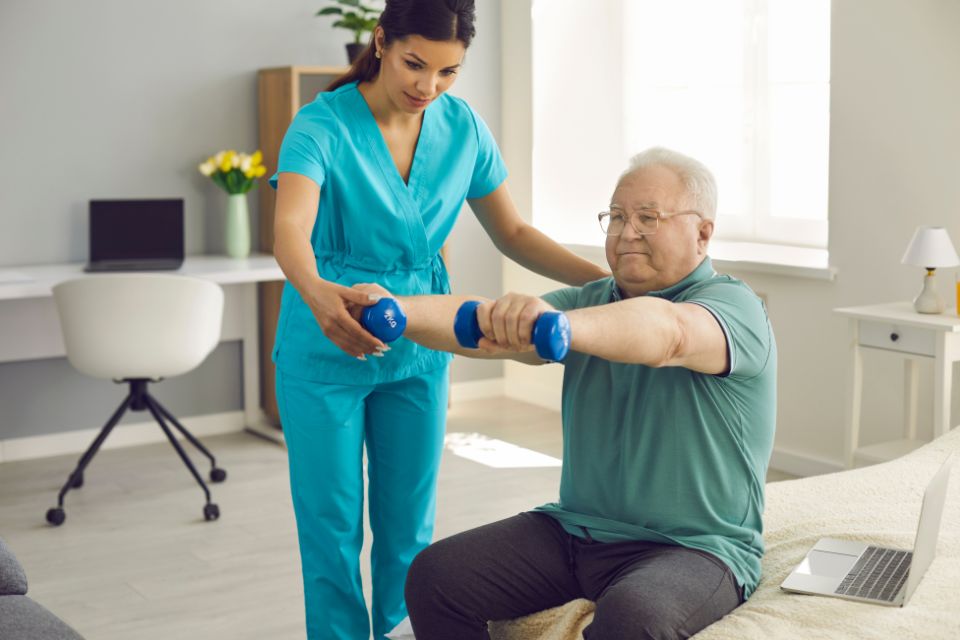
Key Takeaways
- Senior rehabilitation is specialized care that helps elderly adults recover after a hospital stay.
- Rehabilitation often involves a combination of physical, occupational, and speech therapies tailored to each individual’s needs.
- Choosing the right rehabilitation facility is crucial and depends on the senior’s specific health conditions and personal preferences.
- Rehabilitation can be a short-term or long-term process, aiming to restore as much independence as possible.
- Understanding insurance coverage and exploring alternative funding options are essential for managing the costs of rehabilitation.
What You Must Know About Senior Rehabilitation
When our loved ones return from a hospital stay, we want nothing more than to see them recover fully and enjoy life again. Senior rehabilitation is the bridge between hospital care and returning home, designed to help elderly adults regain their strength and independence. Let’s dive into what senior rehabilitation entails and how it can benefit those we care about most.
Defining Senior Rehabilitation
Senior rehabilitation refers to the specialized care provided to elderly patients after a hospital stay. Whether it’s recovering from surgery, a fall, or an illness, rehabilitation aims to help seniors bounce back. It’s not just about physical healing; it’s about restoring the whole person to their best possible state of health and well-being.
Primary Goals of Rehab for Seniors
The goals of rehabilitation for seniors are quite straightforward:
- Improving Physical Function: To increase mobility, balance, and strength through targeted exercises.
- Enhancing Daily Living Skills: To regain the ability to perform everyday tasks with ease and confidence.
- Communication: To address any speech or swallowing difficulties that may have arisen due to illness or injury.
The Healing Journey Begins
Recovery doesn’t happen overnight. It’s a journey that starts with a smooth transition from hospital to rehab. Let’s explore how this transition can set the stage for successful recovery.
Transitioning From Hospital to Rehab
Leaving the hospital is just the first step. What comes next is crucial: choosing the right rehabilitation setting. It could be a specialized rehab facility, at-home care, or outpatient services. The choice largely depends on the senior’s specific needs and the level of care required for their particular condition.
The Role of a Multidisciplinary Team
Recovery is a team effort. A multidisciplinary team of healthcare professionals, including doctors, nurses, physical therapists, occupational therapists, and speech-language pathologists, work together to create a comprehensive rehab plan. They assess the senior’s needs and work in tandem to help them regain their independence.
Unlocking the Power of Physical Therapy
Physical therapy is a cornerstone of senior rehabilitation. It’s all about getting back on your feet and regaining the strength to move around safely. Therapists use a variety of exercises and equipment to address each senior’s unique challenges.
For example, after a hip replacement surgery, a physical therapist might work with a senior on exercises to improve hip strength and flexibility, while also teaching them how to walk with a walker or cane.
Exercises Tailored to Seniors
The exercises prescribed in physical therapy are carefully chosen to match the senior’s fitness level and recovery goals. They might start with basic stretches and gradually progress to more challenging tasks, always with the aim of improving function and reducing pain.
Regaining mobility and strength is often a priority in the recovery process. Physical therapists focus on exercises that improve endurance and muscle function, which are critical for seniors to perform daily tasks and maintain their independence. But physical therapy goes beyond just exercise. It also educates seniors on how to prevent further injuries and manage their current conditions effectively.
Mastering Everyday Activities
Occupational therapy is another key component of senior rehabilitation. It zeroes in on helping seniors master the everyday activities that are crucial to their independence, such as dressing, cooking, and bathing. Occupational therapists assess the home environment and suggest practical modifications to make these daily tasks easier and safer.
Adapting to New Routines
Adapting to new physical limitations can be challenging. Occupational therapists help seniors develop new routines and strategies to compensate for any deficits. This might include teaching them how to use adaptive equipment or modify tasks to make them more manageable.
- Using a grabber tool to pick up items without bending over.
- Installing handrails in the bathroom for stability during bathing.
- Learning new cooking techniques that require less standing or chopping.
Adaptations like these enable seniors to continue living as independently as possible, which is essential for their self-esteem and quality of life.
Overcoming Communication Barriers with Speech Therapy
Speech therapy is an integral part of the rehabilitation process for many seniors, especially those who have experienced a stroke or other neurological conditions. Speech therapists work to improve communication abilities and address swallowing disorders, ensuring that seniors can express themselves clearly and consume food safely.
Improving Speech and Swallowing
Improving speech and swallowing involves a variety of techniques and exercises. Speech therapists might use muscle-strengthening activities to enhance speech clarity or strategies to help with language comprehension. For swallowing difficulties, they may introduce texture-modified diets or exercises to strengthen the muscles used in swallowing.
Tools for Better Communication
Speech therapists also provide tools to aid communication, such as picture boards or electronic devices for those who struggle with verbal communication. These tools empower seniors to express their needs and interact with others, which is vital for their overall well-being.
Social and Emotional Recovery
The road to recovery isn’t just physical; it’s also social and emotional. Building confidence and re-establishing social skills are crucial for seniors to feel connected and avoid the isolation that can often accompany recovery.
Building Confidence and Social Skills
Rehabilitation programs often include group activities that help seniors interact with others facing similar challenges. These interactions foster a sense of community and support, which can boost confidence and encourage a positive outlook on recovery.
Seniors who engage in social activities during their rehabilitation tend to have better outcomes. The camaraderie and shared experiences can be incredibly motivating, giving seniors the push they need to keep working toward their recovery goals.
Joan, a 78-year-old recovering from knee surgery, found that participating in group therapy sessions not only helped her regain her mobility but also allowed her to make new friends who understood her struggles. This social support became a key factor in her successful recovery.
Support Networks and Group Therapies
Having a strong support network is essential during rehabilitation. Family, friends, and caregivers play a vital role in providing encouragement and assistance. Group therapies, whether for physical activities or emotional support, provide an additional layer of community that can make a significant difference in a senior’s recovery journey.
Planning for the Future: Post-Rehabilitation Life
Thinking ahead to life after rehabilitation is important. Making the home environment safe and accessible can prevent accidents and promote independence. Let’s look at how we can prepare for a successful transition back to everyday life.
Home Modifications for Safety and Accessibility
Home modifications can greatly increase safety and accessibility for seniors after rehabilitation. These might include:
- Installing ramps for wheelchair access.
- Adding grab bars in the bathroom and beside the bed.
- Adjusting counter heights in the kitchen for easier access.
These changes not only make it easier for seniors to navigate their homes but also give them the confidence to perform tasks on their own.
Continued Care and Therapy at Home
Recovery doesn’t end when the formal rehabilitation program does. Many seniors benefit from continued care and therapy at home. This might involve home health aides, ongoing physical therapy sessions, or regular check-ins with healthcare providers to ensure that recovery is on track.
Consistency is key. Continuing the exercises and strategies learned in rehabilitation helps maintain the progress made and can even lead to further improvements over time.
Navigating Coverage and Benefits
One of the most pressing concerns for families is understanding what rehabilitation services are covered by insurance. It’s essential to review the senior’s insurance policy to determine which services are included and the duration of coverage. Medicare, for instance, typically covers certain types of rehabilitation services under specific conditions, but it’s important to know the limits and requirements.
Exploring Alternative Funding Options
When insurance doesn’t cover all the costs, there are other options to consider. Many families look into:
- Medicaid for those who qualify based on income and assets.
- Veterans benefits, if the senior served in the military.
- Charitable organizations that offer grants or assistance for seniors.
Exploring these avenues can provide additional support to manage the financial aspects of rehabilitation.
Frequently Asked Questions
There are always questions when it comes to senior rehabilitation. Let’s address some of the most common ones to help you make informed decisions for your loved one’s care.
How Long Does Senior Rehabilitation Typically Last?
The duration of rehabilitation varies depending on the individual’s specific health condition and recovery progress. Some may need a few weeks, while others might require several months. The rehab team will continuously evaluate progress and adjust the plan as needed.
- Short-term rehab: Typically lasts from a few days to a few weeks.
- Long-term rehab: Can extend for several months, depending on the senior’s needs.
Most importantly, the goal is to ensure that seniors recover to the best of their ability within a timeframe that suits their unique situation.
Can Rehabilitation Be Done at Home?
Yes, rehabilitation can often be done at home, especially if the senior’s condition allows for it and the home environment is suitable. Home health services can provide physical, occupational, and speech therapy, as well as nursing care.
What If My Loved One Is Resistant to Rehab?
Resistance to rehabilitation is not uncommon. It’s important to have an open and honest conversation about the benefits of rehab and how it can improve quality of life. Sometimes, hearing success stories from others who have gone through similar experiences can help.
Are There Rehabilitation Services for Specific Conditions?
Yes, there are specialized rehabilitation services for conditions like stroke, hip and knee replacements, and cardiac events. These programs are designed to address the specific challenges associated with each condition.
How Do I Choose the Right Rehabilitation Facility?
Choosing the right rehabilitation facility involves several factors:
- Ensure the facility has experience with the senior’s specific health condition.
- Consider the location for ease of family visits and support.
- Look for a facility with a comprehensive approach to care, including a multidisciplinary team.
- Check the facility’s ratings and reviews for quality of care.
Ultimately, the decision should be based on where your loved one will feel most comfortable and receive the best possible care for their needs.







Recent Comments